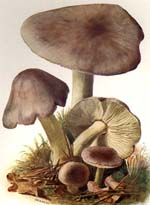 Key to Gilled Mushrooms Key
Key to Gilled Mushrooms KeyThis is a key to gilled mushrooms, that is, mushrooms having a definite cap with a fertile surface consisting of gills. The fruiting body usually also has a stem, although that may be lateral or absent (usually, then, the mushroom is growing from wood). You can use this key to identify mushrooms that you find.
 Agaricales Order
Agaricales OrderFruiting body containing fibers (usually in the stalk)
 White Spored Suborder
White Spored SuborderSpore print "light-colored": white or buff, sometimes tinged with pink or tan. Greenish and (except for the Russulales) yellow spore prints also go here
Stalk fibrous, not fracturing like a piece of chalk
 Tricholomataceae Family
Tricholomataceae FamilyNone of the special features distinguishing the other white-spored genera:
Gills not free, as in the Lepiotas and Amanitas
Basidia not extra-long, as in the Hygrophoraceae
Spores smooth, except for Lentinellus
 Terrestrial Trich Subfamily
Terrestrial Trich SubfamilyGrowing on the ground
 Woodland Normal Trich Tribe
Woodland Normal Trich TribeFound in woods
Not rooting
 Tricholoma-like Fungi Subtribe
Tricholoma-like Fungi SubtribeWoodland habitat (mycorrhizal)
Stem fleshy, not rooting
Tricholoma Genus (Fries) Staude

Diagnosis
Microscropic Characters
Comments
If the diagnosis seems vague to you, you are perceptive; this is a very variable group. Luckily, we don't have to stress about identifying them much in Illinois, as all Tricholomas are mycorrhizal forest creatures, rarely found here since our forests suck. On the theory that some of you may go to Wisconsin, Michigan, or some other place with good forests, I've provided three representative species, whch may end up getting expanded into three (artificial) sections of the genus
For more detailed information on the genus Tricholoma, see the Montreal Mycological Circle's Tricholoma site.
Narrow down your identification:
 Tricholoma caligatum
Tricholoma caligatumCap with coarse scales and fibers
With an armilla; the part that sheathes the stem breaking up into patches as the stem grows
 Tricholoma flavovirens
Tricholoma flavovirensCap yellow with darker center
Under pine
Often only partially emerging from the ground
 Tricholoma saponaceum
Tricholoma saponaceumGrey cap
For more detailed information on the genus Tricholoma, see the Montreal Mycological Circle's Tricholoma site.






 Key to Gilled Mushrooms Key
Key to Gilled Mushrooms Key Agaricales Order
Agaricales Order White Spored Suborder
White Spored Suborder Tricholomataceae Family
Tricholomataceae Family Terrestrial Trich Subfamily
Terrestrial Trich Subfamily Woodland Normal Trich Tribe
Woodland Normal Trich Tribe
 Tricholoma caligatum
Tricholoma caligatum Tricholoma saponaceum
Tricholoma saponaceum




